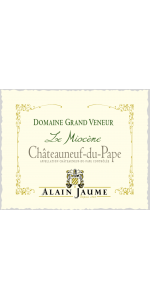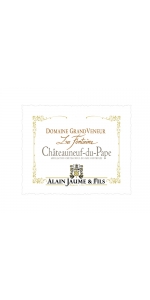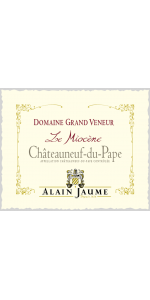Grand Veneur Chateauneuf du Pape Blanc Le Miocene 2022
| Country: | France |
| Regions: | Rhone Chateauneuf du Pape |
| Winery: | Grand Veneur |
| Grape Type: | Clairette |
| Organic: | Yes |
| Vintage: | 2022 |
| Bottle Size: | 750 ml |
Grand Veneur Chateauneuf du Pape Blanc Le Miocene is made from 60% Clairette, 40% Roussanne
Pale yellow colour with hints of green, aromas of white flowers (may blossom, honeysuckle).
The palate is pleasantly balanced between liveliness and roundness, which brings out characteristics of dried apricot, honey and elderberry. A Châteauneuf du Pape white displaying a great finesse.
Best between 1 and 8 years.
Soil type Coming from the single vineyard named “La Fontaine”, the plot is facing north.It is made of clay-sand and limestone. Thanks to the northern orientation, it is always very well aired. This sector allow the Roussane and Clairette to mature in great conditions without losing freshness, which we believe is key point. Winemaking & ageing Whole-bunch pressing. Vinification in stainless-steel tanks. Fermentation temperature controlled at 15°C.
Review:
"The classic white from this estate is the 2021 Châteauneuf Du Pape Le Miocene Blanc, and it shines in the vintage. Based on 60% Clairette and 40% Roussanne, it has a lighter gold hue as well as textbook aromatics of citrus, pears, and minty herbs. I love its balance, it’s medium-bodied, has the vintage’s fresher style, and outstanding length. It should evolve gracefully, and while the safe bet is to enjoy bottles over the coming 2-4 years, I wouldn’t be surprised to see this evolve for well over a decade."
- Jeb Dunnuck (November 2022), 92 pts
Grand Veneur Chateauneuf du Pape Blanc Le Miocene is made from 60% Clairette, 40% Roussanne
Pale yellow colour with hints of green, aromas of white flowers (may blossom, honeysuckle).
The palate is pleasantly balanced between liveliness and roundness, which brings out characteristics of dried apricot, honey and elderberry. A Châteauneuf du Pape white displaying a great finesse.
Best between 1 and 8 years.
Soil type Coming from the single vineyard named “La Fontaine”, the plot is facing north.It is made of clay-sand and limestone. Thanks to the northern orientation, it is always very well aired. This sector allow the Roussane and Clairette to mature in great conditions without losing freshness, which we believe is key point. Winemaking & ageing Whole-bunch pressing. Vinification in stainless-steel tanks. Fermentation temperature controlled at 15°C.
Review:
"The 2023 Châteauneuf du Pape Le Miocene Blanc is mostly Clairette but includes 40% Roussanne. Its vivid gold hue is followed by a beautiful perfume of stone fruits, grilled peach, minty flowers, and some spicy nuances. It's balanced and medium to full-bodied, with a kiss of background oak and flawless balance. It's a brilliant white from this talented family that readers will love to drink over the coming 4-6 years, if not upwards of a decade."
- Jeb Dunnuck (Importer Highlight: Fran Kysela ; July 2024), 93 pts
Grand Veneur Chateauneuf Du Pape Blanc La Fontaine is made from 100% Roussane.
Yellow-gold color. The nose is rich in aromas of citrus fruit, tropical fruit, quince and honey, with a touch of vanilla. On the palate, the same aromas appear together with a fatness combining exotic fruit and vanilla : the wine is rich, generous and elegant, with extraordinary length. "La Fontaine" is often considered to be one of the best Châteauneuf du Pape white, and it is by definition a superb gastronomy wine.
Best between 1 and 8 years.
Review:
"Always all Roussanne, the 2022 Châteauneuf du Pape La Fontaine Blanc comes from organically grown grapes and was brought up entirely in oak. It's a brilliant white that would compete with a Grand Cru White Burgundy with its smoky stone fruits, brioche, crushed stone, and floral aromatics. Full-bodied on the palate, with a deep, layered mouthfeel, huge richness, and a great finish, this is legit awesome white wine that I'd be thrilled to have in the cellar. I love it today yet see no reason it shouldn't evolve gracefully for at least a decade."
- Jeb Dunnuck (Importer Highlight: Fran Kysela ; July 2024), 97 pts
Grand Veneur Chateauneuf Du Pape Blanc La Fontaine is made from 100% Roussane.
Yellow-gold color. The nose is rich in aromas of citrus fruit, tropical fruit, quince and honey, with a touch of vanilla. On the palate, the same aromas appear together with a fatness combining exotic fruit and vanilla : the wine is rich, generous and elegant, with extraordinary length. "La Fontaine" is often considered to be one of the best Châteauneuf du Pape white, and it is by definition a superb gastronomy wine.
Best between 1 and 8 years.
Review:
"The 2021 Châteauneuf Du Pape La Fontaine Blanc is a much more concentrated, serious wine, and it takes plenty of air to show at its best today. Based on Roussanne, it has a medium gold hue as well as rich aromatics of honeyed stone fruits, orange blossom, caramelized peach, and toasted bread. Beautiful on the palate as well, it’s medium-bodied, has a layered, concentrated mouthfeel, good acidity, and a great finish. Give it a year or three in the cellar and enjoy over the following decade."
- Jeb Dunnuck (November 2022), 94 pts
Grand Veneur Chateauneuf Du Pape Blanc La Fontaine is made from 100% Roussane.
Yellow-gold color. The nose is rich in aromas of citrus fruit, tropical fruit, quince and honey, with a touch of vanilla. On the palate, the same aromas appear together with a fatness combining exotic fruit and vanilla : the wine is rich, generous and elegant, with extraordinary length. "La Fontaine" is often considered to be one of the best Châteauneuf du Pape white, and it is by definition a superb gastronomy wine.
Best between 1 and 8 years.
Grand Veneur Chateauneuf du Pape Rouge Le Miocene is made from 70% Grenache, 20% Syrah, 10% Mourvèdre .
An intense dark-ruby color. The nose develop aromas of ripe black fruit (such as blackberry), cherry and spice box. The palate reveals the presence of tannins, in high quantity and elegant. The finish is long and luxurious. This is the Châteauneuf du Pape expression, displaying all the characteristics of the terroir.
Soil type: Plots are located northern part of Châteauneuf du Pape and the vines are grown under organic process.The soil is marked by the violence wrought by the Rhone river. It consists of a layer of marine molasses of the Miocene period covered by alpine alluvium. The presence of a great number of rounded stones known as "galets" in the earth is evidence of the time when the Rhone, then a torrent, tore fragments of rock from the Alps and deposited them on the plain. The GRAND VENEUR cuvee will express year after year a great power and aromatic complexity.
Winemaking & ageing: Harvest is sorted by hand, destemmed and crushed. Fermentation temperature is controlled at 30°C. Vatting period of 18 to 20 days. Matured in vats and oak casks.
Review:
The 2022 Châteauneuf du Pape Le Miocene checks in as 70% Grenache, 20% Syrah, and the rest Mourvèdre, all destemmed, that was raised mostly in tank, with the Syrah and Mourvèdre in oak. It has a beautiful nose of ripe red and black fruits that give way to more licorice, black olive, peppery garrigue, and spices. Medium to full-bodied on the palate, it's balanced and has ripe, building tannins and a great finish. It's going to evolve gracefully for 10-12+ years.
-Jeb Dunnuck 93 Points
Grand Veneur Chateauneuf du Pape Blanc Le Miocene is made from 60% Clairette, 40% Roussanne
Pale yellow colour with hints of green, aromas of white flowers (may blossom, honeysuckle).
The palate is pleasantly balanced between liveliness and roundness, which brings out characteristics of dried apricot, honey and elderberry. A Châteauneuf du Pape white displaying a great finesse.
Best between 1 and 8 years.
Soil type Coming from the single vineyard named “La Fontaine”, the plot is facing north.It is made of clay-sand and limestone. Thanks to the northern orientation, it is always very well aired. This sector allow the Roussane and Clairette to mature in great conditions without losing freshness, which we believe is key point. Winemaking & ageing Whole-bunch pressing. Vinification in stainless-steel tanks. Fermentation temperature controlled at 15°C.
The Grand Veneur Estate
In 1320 Pope Jean XXII planted the first vines of Chateauneuf-du-Pape, but it was only in 1360 that the wines of the region first gained fame. Oddly, the wine that gave Chateauneuf-du-Pape its original reputation was the Blanc and not the Rouge. The white wine was a favorite of Pope Innocent VI. The Domaine dates back to 1826, having been founded at that time by Mathieu Jaume. Since 1979, Alain Jaume has run the Domaine and now has the help of his two sons: Sebastien and Christophe.
"Popes throughout history have liked their juice, and when the papal see moved to Avignon in the 13th century, that juice was Chateauneuf-du-Pape ("the pope's new castle") made from grapes grown nearby in the Southern Rhone. The castle is a ruin now, the papal court long gone back to Rome, but the wines that bear the pope's coat of arms emblazoned on the bottle are still produced more or less according to the long-standing recipe. Not every winemaker uses all 13 of the grapes in the proscribed blend, though. At Domaine Grand Veneur, an estate that dates to 1826, Alain Jaume and his sons Sebastien and Christophe emphasize Grenache blended with Syrah and Mourvedre."
- Los Angeles Times
"Improved Chateauneuf with very accomplished, stylish reds since the late 1990s; also very good Vacqueyras and Cotes-du-Rhone Villages." - Anthony Dias Blue's pocket guide to wine 2006
"Grand Veneur is one of the most brilliant estates in Chateauneuf du Pape as well as the force behind the negociant wines sold under the Alain Jaume label. Virtually everything they produce has merit. Some of this estate’s 2009 red wines are just hitting the market as they are bottled early to preserve their fruit and freshness. I can’t say enough about the job Alain Jaume’s two sons, Sebastian and Christophe, have done with this estate. The impeccable attention to detail in the vineyards, the meticulous vinification, and the careful bottling benefit every consumer." - Wine Advocate (#190, August 2010)
"Great bargains continue to emerge from Domaine Grand Veneur as well as from their negociant arm of the business, labeled Alain Jaume" - Wine Advocate (#195, June 2011)
"Don't miss the following "Best Buys" reviewed in several previous issues: Alain Jaume 2010 Cotes du Rhone Haut de Brune (87), Grand Veneur 2010 Cotes du Rhone Blanc (88), Grand Veneur 2009 Cotes du Rhone Les Champauvins (89), Grand Veneur 2009 Cotes du Rhone Reserve Blanc (89), Grand Veneur 2010 Cotes du Rhone Blanc (91), Grand Veneur 2010 Cotes du Rhone Rose (86), Grand Veneur 2009 Lirac Clos de Sixte (91), and Grand Veneur 2010 Cotes du Rhone Blanc de Viognier (89). Credit Christophe and Sebastian Jaume for making this one of the most impeccably run estates in the Rhone Valley. To reiterate, this is an estate at the top of its game and the wines remain fairly priced as well. The 2010 Grand Veneur Chateauneuf du Papes reveal youthful, crisper, more focused styles than their 2009 counterparts. I suspect their pHs are lower, the total acids slightly higher, and the alcohols perhaps .5 to 1% lower across the board." - Wine Advocate (issue197, October 2011)"
The Grand Veneur Vineyard
The estate is located in the commune of Orange and consists of 50 hectares (123 acres). It covers four different appellations: Chateauneuf-du-Pape, Cotes-du-Rhone Villages, Cotes-du-Rhone and Lirac.
The family produces wines under two labels:
- Domaine Grand Veneur – Estate
- Alain Jaume – Negociant
Some wine by Grand Veneur:
- Domaine Grand Veneur, Clos de Sixte, Lirac Rouge
- Reserve Grand Veneur, Côtes du Rhône Rouge
- Reserve Grand Veneur, Côtes du Rhône Blanc
- Grand Veneur, Côtes du Rhône "Blanc de Viognier"
- Reserve Grand Veneur, Côtes du Rhône Rosé
- Grand Veneur, Côtes du Rhône Rouge, Les Champauvins
- Grand Veneur, Côtes du Rhône Villages Rouge, Les Champauvins
- Grand Veneur , Châteauneuf-du-Pape Blanc
- Grand Veneur, Châteauneuf-du-Pape Blanc, La Fontaine
- Grand Veneur, Châteauneuf-du-Pape Rouge
- Grand Veneur, Châteauneuf-du-Pape Rouge, Les Origines
- Grand Veneur, Châteauneuf-du-Pape Rouge, Vieilles Vignes
- Domaine Grand Veneur, Marc de Châteauneuf-du-Pape
Annual production:
- Cotes du Rhone Villages CHAMPAUVINS : +/- 9,000 cases
- Lirac Rouge CLOS DE SIXTE : +/- 5,000 cases
- Chateauneuf du Pape Rouge Grand veneur : 3,300 cases
- Chateauneuf du Pape Blanc Grand veneur : 400 cases
- Chateauneuf du Pape LES ORIGINES red : 1,700 cases
- Chateauneuf du Pape LA FONTAINE white : 300 cases
- Chateauneuf du Pape VIEILLES VIGNES : 530 cases
- back
Hailing from the newly established West Sonoma Coast AVA, this inaugural release displays deep ruby in tint with Bing cherry, wild mountain berry, and an ethereal note of damp earth. Vibrant red and blue fruits dance on the palate, accompanied by oyster shell and a stony tension in character with its coastal influences. A silky texture and uplifted acidity add a sophistication and intensity to this wine, as well as a remarkably long finish.
Review:
The 2021 Pinot Noir (West Sonoma Coast), a new wine in this range, is lights out. Rich, ample and bold, the 2021 races across palate with layers of purplish fruit, lavender, spice, menthol, licorice and spice. A dollop of stems adds nuance, but without dominating the overall balance. There's terrific acidity and structure to play off the natural fruit richness that is such a distinctive attribute of the best sites in the appellation.
-Vinous 96 Points
DAOU Vineyards Soul of a Lion is made from 82% Cabernet Sauvignon, 12% Cabernet Franc, 6% Petit Verdot.
Barrel Aged: 22 months in 100% new French oak
Named for the father of Georges and Daniel Daou, Soul of a Lion is the crown jewel of DAOU, and an emblem of our quest to produce unsurpassed Cabernet Sauvignon from the terroir of DAOU Mountain.
The 2021 vintage displays remarkable intensity in the glass with dark, inky ruby-purple hues. Abundant fruit aromas of black cherry, blackberry, blueberry jam and black currant are interwoven with accents of baking spices, sage and graphite. A voluminous entry introduces sumptuous layers of chocolate-covered blueberry, tobacco, mocha, vanilla and toasted oak. The mouthfeel is concentrated and elegant, with round, vibrant tannins that carry into a commanding finish. A wine of immense staying power that will evolve favorably for many years to come.
96-98 Points by Robert Parker
Review:
Extremely dark in the glass, it starts with heavily spiced aromas of vanilla, mocha and walnut cream that balance the rich black cherry and roasted berry fruits. The palate's tannins are immensely grippy yet expertly polished, framing flavors of loam, black olive and graphite.
-Wine Enthusiast 97 Points









